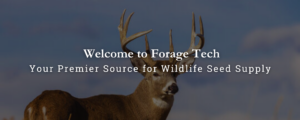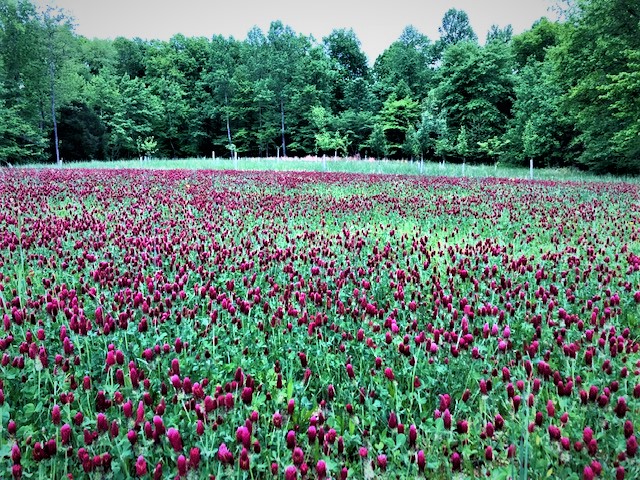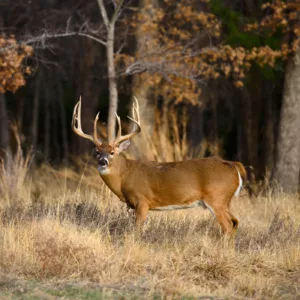
At Forage Tech, we specialize in providing products that maximize wildlife agriculture including a diverse selection of wildlife food plot seeds, wildlife food plot seed mixes, and a specially formulated wildlife food plot fertilizer. Our goal is to assist our customers in maximizing their wildlife agricultural practices, whether for hunting, conservation, or ecological diversity. Understanding the investment our customers make in land, equipment, and resources, we are committed to delivering products that meet and exceed expectations, ensuring successful and thriving wildlife habitats. We have a wide variety of products that we offer with a sample being wildlife fruit trees, nut bearing wildlife trees, clover sprayers, deer/elk minerals and Kunz mowers and cultipackers. Check out our product pages for more information. Also fill out a contact form or text us if you need more information. This website is currently under re-construction so please be patient with us. Our text is 615-397-1638.
 The Importance of Quality Wildlife Seed Supply
The Importance of Quality Wildlife Seed Supply
Quality wildlife seed mix is not just beneficial but essential for the health and proliferation of local wildlife populations. Our wildlife food plot seeds are meticulously selected by scientific research to provide nutrition, soil building and wildlife cover. Forage Tech has a proprietary summer seed mix and a winter seed mix for deer. In addition, Forage Tech sells perennial clover seed, perennial alfalfa seed and combinations of alfalfa and clover, utilizing the best perennial seeds possible. Forage Tech also sells Eagle Forage Soybeans, high quality corn with varying maturing dates for dove or deer, native warm season grass seed, chufa seed for turkeys, buckwheat seed for soil building, teosinte seed for property screening as well as food for quail, turkey and ducks and seed for your dove field plantings and duck plantings. The picture to the left is a picture of the winter seed mix growing on our demonstration farm in Middle Tennessee after spring green up.
 Deep Dive into Forage Tech’s Deer Nutrition Solutions
Deep Dive into Forage Tech’s Deer Nutrition Solutions
When it comes to food plot fertilizers and minerals in Tennessee, we understand the importance of maximizing the potential of your land for optimal trophy deer production and improving the general health of your deer herd. Almost all commercial fertilizers contain three primary nutrients represented by the numbers on the bag such as 15-15-15. That means the fertilizer has three nutrients in the bag. There are six major nutrients and key minor nutrients important for the health of your deer herd. Our fertilizer contains all 6 major nutrients and several key micronutrients. The granular minerals replace salt blocks with a much broader assortment of nutrients than what can be provided by any hard block. We furnish the best bag lime available which is certified organic and contains both calcium and magnesium. Forage Tech also furnishes fish pond fertilizer. We work with a quality lab for soil testing and our staff agronomist prepares a food plot from the soil test for our customers. For those who want to understand deer nutrition more fully, please click on the attached PDF written by our staff Agronomist and Wildlife Biologist.
Forage Tech’s Unique Approach to Wildlife Trees for Your Property
Forage Tech offers a wide range of trees specifically selected for wildlife management and home orchards for the Mid-South and Mid-West, concentrating on USDA Hardiness Zones 4-8. Among our offerings are Chestnut Trees, American Hybrid Chestnut Trees and Allegheny Chinquapin Trees with each of these trees providing four times the protein and four times the carbs of the best White Oak acorns. We also provide Wildlife Fruit Trees including Apple Trees, Crabapple Trees, Tigertooth Jujube Trees, Pear Trees, Green Giant Screening Tree and Persimmon Trees. Besides Chestnut Trees, we provide additional nut producing trees including Tennessee Sweet Pecans, Gobbler Sawtooth Oak Trees and Dwarf Chinkapin Oak Trees that produce abundant nuts perfect for attracting deer, turkey and other wildlife. Most big box stores and volume sellers sell fruit trees grafted on inexpensive rootstock. Forage Tech goes to a huge effort to graft fruit trees to the best roostocks available. We specialize in selling fruit and nut trees from 5′-10′ tall so that they will bear fruit and nuts more quickly than seedlings and provide the best value possible. Whether you are looking to enhance your hunting land or create a wildlife sanctuary or home orchard, our selection of trees is sure to meet your needs. January to the first week of March is the time to plant Wildlife Fruit Trees. Forage Tech has a good selection in stock. Email or text us to discuss your tree needs.
 Wildlife Food Plot Seed: Best Practices For Spreading Seed
Wildlife Food Plot Seed: Best Practices For Spreading Seed
Our company is proud to offer a range of high-quality equipment from Kunz, a trusted name in the industry. Whether you are in need of a reliable cultipacker, a durable mower, or a versatile spreader, we have you covered. Our Kunz cultipackers are designed to provide optimal seed-to-soil contact, ensuring successful germination and growth. Meanwhile, our Kunz mowers are built to handle tough terrain and deliver efficient and precise results. Lastly, our Kunz spreaders are engineered for even and accurate distribution of seed, fertilizer, and other materials. With our selection of Kunz equipment, you can trust that you are investing in top-notch machinery that will exceed your expectations and help you achieve your landscaping and agricultural goals.
 Maximizing Wildlife Agricultural Practices with Forage Tech
Maximizing Wildlife Agricultural Practices with Forage Tech
At Forage Tech, our commitment extends beyond merely providing products; we aim to educate and assist our customers in creating effective wildlife habitats. This involves a deep understanding of the complexities of wildlife food plots and navigating the myriad of products available in the market. Our team, driven by our founder’s expertise as an agronomist, continuously conducts research and tests our products on free-ranging wildlife. This ensures the most effective and reliable wildlife food plot solutions are delivered to you.
 Forage Tech History: A Journey of Innovation and Expertise
Forage Tech History: A Journey of Innovation and Expertise
Forage Tech’s journey began 22 years ago when our agronomist/wildlife biologist founder purchased hunting land. His test plots and seed mix trials led to innovations like the “Bag in a Bag” system, separating large and small seeds for optimal planting. This approach, coupled with recommendations for cover crops and holistic fertilizer development, culminates in our comprehensive product line, including seed mixes, fertilizers, mineral mixes, specialized and quality driven fruit and nut trees as well as small equipment suitable for planting and maintaining fruit trees, wildlife food plots including clover plots and other tasks for those involved in wildlife agriculture.
Our Commitment to Quality and Environmental Stewardship
Proud of our journey and expertise, Forage Tech invites you to experience the difference in quality, innovation, and commitment to wildlife and the environment. Join us in creating well-managed wildlife food plots as key components of conservation and land stewardship. Our mission is to provide high-quality products that promote the well-being of wildlife, the environment, and those who steward the land.
Forage Tech Learning Center
Check out the Learning Center by clicking here. This will take you to information about lime and pH, fertilizers, mineral mix uses, soils, clearing food plots, planting techniques and equipment, exclusion baskets, and a host of other articles to keep you informed and educated on wildlife habitat management.


